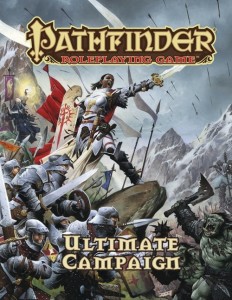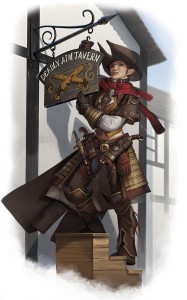 This week I have been busily reading the wonders of Chapter 2: Downtime in the Ultimate Campaign Sourcebook. The initial pages had me frowning and also getting rather pleased that I would have something meaty to criticize in the book. To find out if that is the truth when I finished reading the chapter read on!
This week I have been busily reading the wonders of Chapter 2: Downtime in the Ultimate Campaign Sourcebook. The initial pages had me frowning and also getting rather pleased that I would have something meaty to criticize in the book. To find out if that is the truth when I finished reading the chapter read on!
Chapter 2: Downtime
This chapter looks wholly and solely at a thing called downtime for the players. You have heard about it I am sure. You know, that time where your character is hanging around the town with not a lot to do with themselves. I am being a little facetious here because this type of time in my game is a little bit of a mythical creature. That is, everyone has heard of it but they (the characters) have never seen any.
Of course that is not true of every campaign I have run. In my Earthdawn campaign I ran well over a decade ago it was all about the character motivations. They built a group building in Bartertown and one of the players (a Nethermancer) hollowed out a living Kraken and used it as his “tower” where he spent a lot of time creating lifeforms to serve him. Yes, it was weird but very cool at the same time. Beyond all of that though, most of the reading that I do tells me that the heroes are, well, heroic and that they don’t spend time drinking in a tavern when there are kingdoms to be saved and monsters to be killed.
In essence my own personal group do not get a great deal of time to sit around and talk about the weather with locals so I was so ready to do this with this chapter. The first part of the chapter introduced something that really irks me with sourcebooks. It introduced an economic system that sits on top of the current economic system to make a “Downtime system”. So much added complexity I could see occurring from these new rules. It was meant to model expenditure in doing stuff for the mythical downtime your character gets, including things like goods, labour, influence and magic. I smiled a wry smile at the thoughts of writing this blog. Here was the fatal flaw to this book.
Well, it actually pained me so much that I could not go back to the chapter for a while. I was very disappointed, so I started reading Fate Core again as well as Dungeon World and the latest module from Paizo: The Dragon’s Demand. It was only late in the week that I braved picking up the book again and realized I should have pushed on through.
This chapter adds a load of complexity to what is meant to be quiet time for characters. So why do it? Well, I kept reading, and as I did, I found myself wanting to be a player with a GM that uses this book. I wanted to do some of the stuff located in the chapter. I wanted to buy a tavern and run a thieve’s guild. I wanted to make a castle with a throne room and an altar! This is what this chapter does!
It gives the player options on what they can do in their local settlement. They can set up buildings that become a source of income (as well as a source of drama). Not only buildings though. It also covers how to get a group together that work for you while you are away. And it is in that way that they failed this chapter. Not by providing all this, but by the way they organized the chapter.
 At the start of the chapter it details the structure of its economic system it is going to apply and then rather than getting into the seriously cool stuff they talk about what happens while you are all out adventuring. They talk about resource depreciation and economics and snoooooooore… After that they detail managers you can use to run your stuff. They connect the Leadership Feat really well to some of this stuff and then show you how to build buildings and teams by using your Goods, Labor, Magic and Influence. They provide a way to make your building one room at a time providing an awesome number of rooms for you to look over. Also they provide a number of groups you can hire on too to create your Thieve’s Guild or Mercenary Company.
At the start of the chapter it details the structure of its economic system it is going to apply and then rather than getting into the seriously cool stuff they talk about what happens while you are all out adventuring. They talk about resource depreciation and economics and snoooooooore… After that they detail managers you can use to run your stuff. They connect the Leadership Feat really well to some of this stuff and then show you how to build buildings and teams by using your Goods, Labor, Magic and Influence. They provide a way to make your building one room at a time providing an awesome number of rooms for you to look over. Also they provide a number of groups you can hire on too to create your Thieve’s Guild or Mercenary Company.
The rooms section is excellent. I can not tell you how many times as a teenager I went to map a castle out and built my throne room a few bedrooms, a prisoner dungeon and a gatehouse with moat and said “What am I missing?” Well let me tell you, the answer to my questions lay within these pages. I smiled at the extensive list and imagined myself with a seventeen story palace with every one of the detailed rooms located inside. I am seriously going to build a few places up and build some maps using this. Which reminds me, they provide some nice maps of a select few of the buildings included too!
The last thing that I am yet to mention is they provide a kind of random encounter list of things that happen for generic buildings and also specific lists for a lot of the buildings. These contain some excellent adventure hooks to whet the players appetite that a GM could easily build into a nice little side adventure while the players are just working on their own thing.
So, there you have it. this chapter needs to be reorganized. It should have interesting stuff first so everyone gets enthused about what they can do and then learn the boring stuff of what happens when you are gone after it. I can see there may be readers out there that may just skip this chapter after the first six pages of grueling agony. Had I read the second half first I would actually care about what they wrote in the first half. I would be open mouthed in shock about how my seventeen story palace could degrade while I was away. Truly I would.
But this chapter has also convinced me that I should give my players some down time and encourage them to invest in their characters. One of my players in the Serpent Skull game always wanted to set up a survival camp on Smuggler’s Shiv (the island you get shipwrecked on in the start of the module) and this would be perfect for that. I have been inspired by this chapter to include a new, character forming, dimension to my games. That is after all what core rule expansions are meant to do right?
So, next week we will be moving into the wonders of Chapter 3: Campaign Systems. Something that I have a strong interest in and have written pretty extensively on with this and my own blog. It is this chapter that I was exceptionally keen to get my hands on when I heard of this sourcebook. So join me in a week as we unpack it in my next blog. Until then, keep rolling!

So far, I’m loving the book. It has proven to be very useful in, due to my players constantly just hanging around in town trying to figure out what to do. Even when I throw adventure hooks and plot points in they just wander around mucking up the town with their presence.
It has added some interesting things that they have taken into consideration.
I have not picked up a copy yet, but between Mark’s review and my local GMs impression – it looks like a good book to have for a Pathfinder game.
It does seem to add a lot of flesh to the bones of things that players like to do or make use of. As I read further and further in this book it is like a face palm moment wondering why hasn’t someone (including me) thought of some of this stuff before!